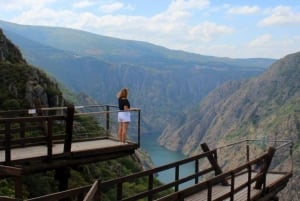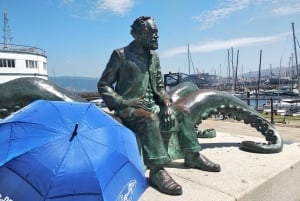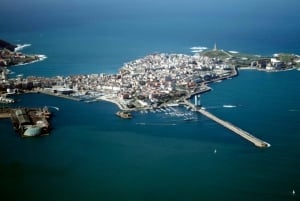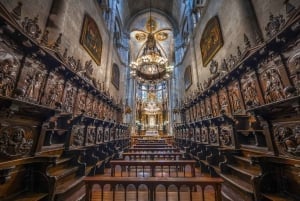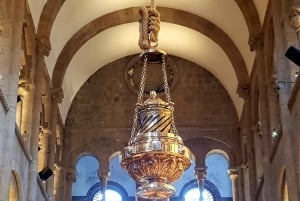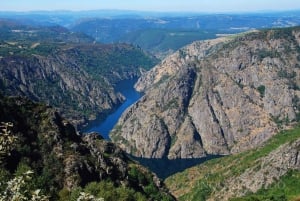La Coruna
With a population of nearly 245,000 La Coruña is the main financial and business centre in Galicia, stunningly located on a small peninsular surrounded by the sea on all sides. It is a major port city and in summer cruise liners frequently stop on route to the Mediterranean which makes for an impressive sight. Although a lot of the buildings are relatively modern in appearance, the old town is well preserved focused around the Town Hall and main square. Renowned for being a fashion centre thanks to being home to world famous brands such as Zara, Massimo Dutti and Caramelo, it's a place to go shopping in its maze of tightly knitted streets centred on Calle Real which adds to the experience. There is a large beach in the centre which is vibrant in the summer. La Coruña is a very welcoming place with some of the best restaurants in Spain and superb nightlife where the visitor is openly welcomed and guaranteed to have a great meal and good time.
La Coruña is sometimes called the White or Glass City which can really be appreciated looking from the Port (Dársena de la Marina/Puerta Real) towards the waterfront and entrance to the City Square. The buildings here have a unified appearance with white painted, glass balconies/facades which give protection from wind and rain. Behind these buildings is the Praza (Galician for square) de Maria Pita with traditional designed, colonnaded buildings facing onto a very impressive, large square at the heart of which is a statue of Maria Pita waving a spear. She is a local heroine who helped to repel an English siege in 1589 killing many English soldiers in the process!
| Views looking towards the Dársena |
 |
| by nadia_the_witch @ flickr.com |
From the Dársena is the Paseo MarÃtimo which is largest, continuous walkway in Europe running around the entire peninsular of the city. This is where the city's inhabitants gather especially in the summer evenings for a stroll taking in the setting of the city against the Atlantic Ocean and looking across the rÃas to Ferrol from various points. It is also possible to catch a ride on a tram based on a replica of one which used to run around the city in the 1920s. The new Dársena also contains a lot of facilities including shops and bars and where businesses associated with the fishing industry are clustered.
Some walking distance along this route to the north of the centre and perhaps the most popular place of interest in La Coruña is the Torre de Hercules, the only working roman lighthouse in the world which although largely rebuilt dominates the skyline standing above its rocky outcrop setting to warn ships off the dangerous Costa da Morte.
| Torre de Hercules |
 |
| by Moncho Piñeiro -- 'SIN - Photoshop' @ flickr.com |
La Coruña was first brought to the attention of a wider, world audience thanks in part to the recent success of the local football team Deportivo La Coruña (as well as the efforts of the local Council) who won La Liga for the first time in 2000 and not long after reached the semi-finals of the Champions League. El Riazor Stadium is superbly located almost jutting out of the sea and the walk along the beaches of the Riazor and Orzan towards the football stadium especially on match days is an unforgettable experience. The football here is to the locals like going to the theatre, so is popular with all the family including the grandparents!!
Riazor Stadium- Home of Real Club Deportivo de Coruna
 |
There are a number of museums worth visiting including the Museum of Mankind (Museo Domus), a science museum (Casa de las Sciencias), and the aquarium which is stunningly located close to the Torre de Hercules, the Museo Militar, Museo Bellas Artes and the Castelo San Anton which houses the Museo Arqueológico e Histórico. In addition, entertainment venues include the Opera Hall, Coliseum, RosalÃa and Colon Theatre. There are exceptional views of the whole city from the modern lift Ascensor Panorámico Monte San Pedro.
| Views form Ascensor |
 |
| by santinet @ flickr.com |
La Coruña is a gastronomic delight and people come from all over Spain to enjoy the local Galician specialities and lunch in most bars and restaurants is a great, dining experience. The introduction to local eating habits is really illuminating where the art of eating delicious freshly caught seafood in an efficient and dignified way has been perfected by successive generations of local inhabitants! The most expensive local seafood delicacy is percebes which is a goose barnacle. These small, claw-like shellfish cling in clusters to the rocks between high and low tide and have to be hacked away at great risk as the sea constantly crashes making this the most dangerous fishing practice in the world. To cook they are boiled for a minute in salty water with laurel leaves and then served in a large, steaming pot. The art of eating them is a real culinary experience with the secret being to twist the tip of the claw to lift the skin and reveal the tiny stalk of juicy meat underneath which is a soft brownish stump and tastes heavenly of the sea similar to crab meat or lobster! No trip is complete without savouring a tapa or two in the streets surrounding Calle Barrera (off Calle Real) where the visitor will receive a very warm welcome and special experience.


